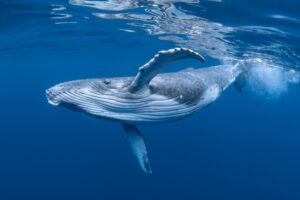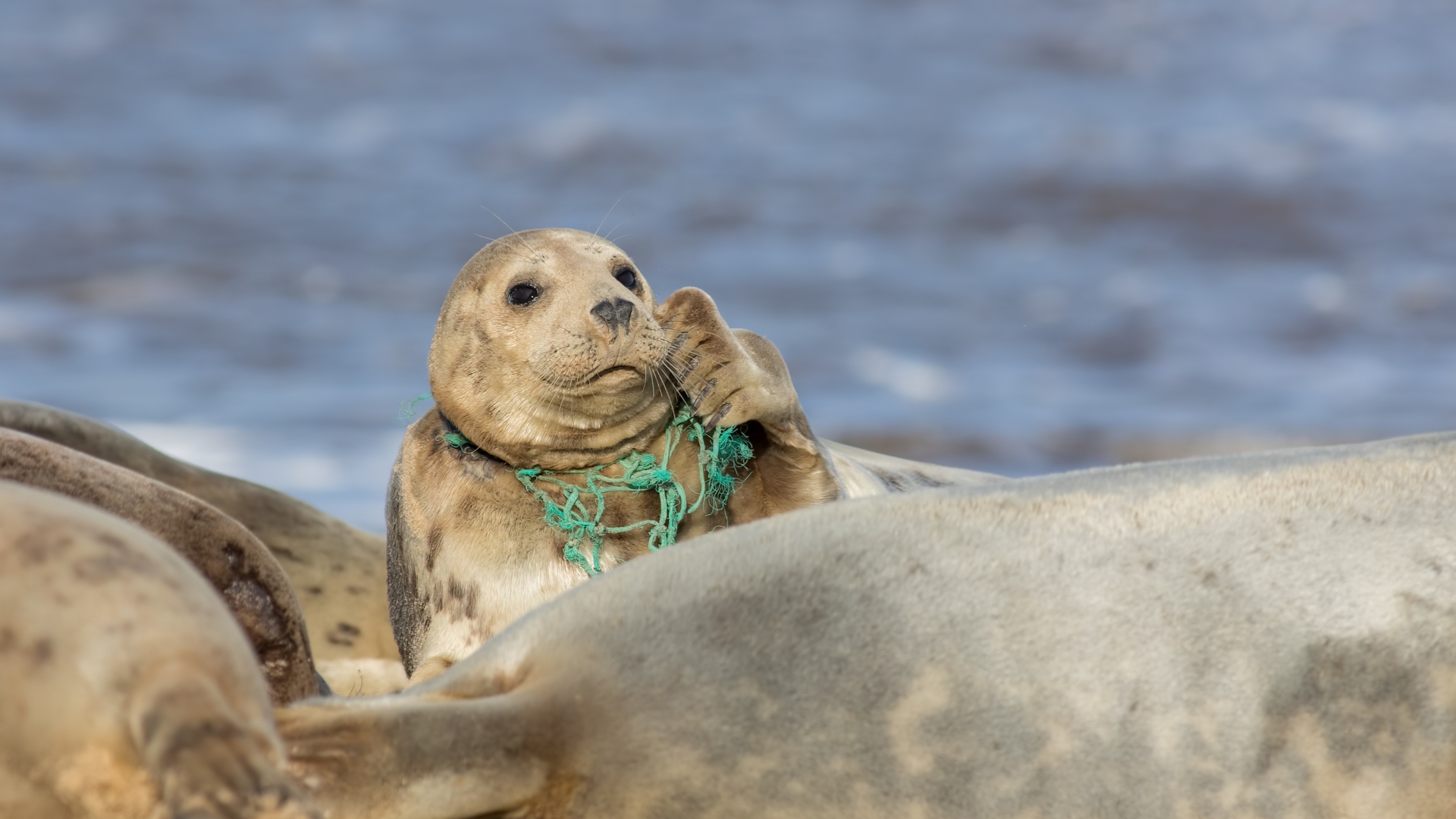World Oceans Day: Four ways we are harming marine life
Written by Olivia Nater | Published: June 8, 2023
Today, June 8th, is World Oceans Day, a UN observance day which seeks to raise global awareness of the benefits humans derive from the ocean, the threats it faces, and our collective duty to safeguard marine ecosystems for future generations. Human impact on our blue planet is multifaceted, but some threats to marine life receive a lot more attention than others.
Oceans cover 70% of our planet — as largely terrestrial beings, this is a fact we don’t consider very often. The ocean plays a major role in climate regulation, transporting heat from the equator to the poles. It produces roughly half of the oxygen on Earth, and is home to an estimated two million species, most of which have yet to be described.
While concentrated in drier habitats, the impact of our human population of 8 billion and counting extends even into the deepest, darkest underwater realms. A landmark 2019 UN report estimated that only one-third of marine environments have not yet been “severely altered” by human actions.
Here are four ways that we are harming the ocean, from most to least well-known:
1) Plastic pollution
When people consider human impact on our oceans, many immediately think of plastic pollution — a serious and very visible problem which has been the focus of awareness raising campaigns by prominent environmental organizations, as well as impactful documentaries such as Plastic Planet.
“Beat Plastic Pollution” was the theme for World Environment Day earlier this week (June 5th). The UN observance day highlighted the fact that 11 million metric tons of plastic waste enter the oceans annually. Without intervention, this figure is expected to nearly triple by 2040 owing to population growth, increasing per capita plastic use, and insufficient disposal services.
There is, however, an even more nefarious threat to ocean ecosystems that receives far less attention. The deadliest type of marine plastic pollution gives us a clue: discarded fishing gear, also known as ghost gear.
2) Overfishing
 Industrial fishing activities are by far the greatest threat to marine life, but they occur mainly in the high seas, out of sight for most people. For example, more than a third of sharks and rays are now estimated to be at risk of extinction, primarily due to overfishing.
Industrial fishing activities are by far the greatest threat to marine life, but they occur mainly in the high seas, out of sight for most people. For example, more than a third of sharks and rays are now estimated to be at risk of extinction, primarily due to overfishing.
Thirty-five percent of global fish stocks are being overexploited, meaning they are harvested faster than they can recover. Another 57 percent are being harvested at the maximum level that can be sustained. Intensive fishing operations are also very wasteful — many animals that die in fishing gear, including sharks, sea turtles, and dolphins, are not the intended targets and are tossed overboard as “bycatch.”
Global consumption of seafood and freshwater fish has increased at an average annual rate of 3 percent since 1961, exceeding our average population growth rate of 1.6 percent. Consumption of aquatic foods has doubled from an average of 10 kg (22 lbs) per person per year in the 1960s to over 20 kg (44 lbs) in 2020. Decreasing poverty and changing diets mean demand for animal protein is projected to drive a further 15 percent rise in per person consumption by 2030, which, combined with population growth, spells trouble for oceans.
Aquaculture is increasing more rapidly than fishing activities — while this should in principle help reduce pressure on wild fish populations, fish farming has serious downsides as well. Ironically, a lot of farmed fish are predatory species, which are fed other fish. Approximately one-fifth of the world’s annual wild fish catch is used to make fishmeal and fish oil, of which up to three-quarters is used to feed fish in fish farms. Aquaculture development often drives habitat loss, which can also harm marine and coastal species. In addition, fish farms are a source of disease agents and pollutants, such as antibiotics and excess nutrients which can cause toxic algal blooms.
3) Climate change
Oceans play a critical role in fighting the climate crisis, having absorbed around 31 percent of carbon dioxide emissions between 1994 and 2007, as well as more than 90 percent of the warming that has occurred over the past 50 years.
All that excess carbon is making oceans more acidic, creating conditions that reduce the availability of minerals used to build and maintain shells and other vital structures in calcifying organisms like corals and shellfish.
 Ocean warming is also leading to coral bleaching, whereby heat stress causes corals to expel the symbiotic algae living in their tissues, which can lead to the collapse of entire coral reef ecosystems. According to researchers, 98% of the Great Barrier Reef has been affected by bleaching since 1998, and the Intergovernmental Panel on Climate Change (IPCC) projects that at 1.5°C of warming, coral reefs globally will decline by a further 70-90 percent, and could disappear almost completely under 2°C of warming. Unfortunately, we are currently on track for 2-3°C of warming.
Ocean warming is also leading to coral bleaching, whereby heat stress causes corals to expel the symbiotic algae living in their tissues, which can lead to the collapse of entire coral reef ecosystems. According to researchers, 98% of the Great Barrier Reef has been affected by bleaching since 1998, and the Intergovernmental Panel on Climate Change (IPCC) projects that at 1.5°C of warming, coral reefs globally will decline by a further 70-90 percent, and could disappear almost completely under 2°C of warming. Unfortunately, we are currently on track for 2-3°C of warming.
4) Deep-sea mining
Probably the least well-known, emerging threat to oceans is mineral extraction from the deep seabed. The ocean floor contains precious metals that can be used in electronics, such as nickel, copper, cobalt, manganese, zinc, and gold. Recent advances in underwater technologies combined with increases in the value of gold and other metals are driving a big push to plunder the ocean’s depths.
While industrial mining operations have not yet begun, the International Seabed Authority (ISA), the UN body responsible for regulating deep-sea mining, has so far granted 31 contracts for exploration of the deep seabed. The ISA will start accepting mining applications from companies in July this year.
Deep-sea mining will have wide-reaching environmental impacts. Tearing up the ocean floor will directly harm bottom-dwelling species, while churned-up sediment, toxic wastewater, and noise pollution will pose a risk to animals throughout all oceanic zones.
Changing times, changing tides?
The theme for this year’s World Oceans Day is “Planet Ocean: Tides are changing,” highlighting the need to “put the ocean first.” It is hard to be optimistic in light of all the threats facing our blue planet but there is some reason for hope.
 Remember the trendy “Save the Whales” campaign from the 1970s? A worldwide ban on commercial whaling was instated in 1986, allowing whale populations to bounce back from near extinction. While whales aren’t quite safe yet, this was an enormous victory.
Remember the trendy “Save the Whales” campaign from the 1970s? A worldwide ban on commercial whaling was instated in 1986, allowing whale populations to bounce back from near extinction. While whales aren’t quite safe yet, this was an enormous victory.
In addition, nations agreed last year to protect 30% of marine areas by 2030. If implemented, this would represent a significant improvement from the 3% that are considered effectively protected today. Following almost two decades of negotiations, another historic deal to protect the world’s oceans was reached in March this year. Commonly referred to as the “High Seas Treaty,” the agreement reinforces the goal to establish large-scale protected areas, and aims to assess and regulate damaging activities such as overfishing and deep-sea mining.
Finally, many people are choosing to limit their own “ocean footprint” by reducing their consumption of seafood and avoiding unnecessary plastic packaging. Individual actions may just be drops in the ocean, but with all (16 billion or so) hands on deck, we can indeed make waves of change and turn the tide.

